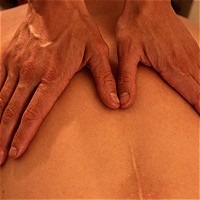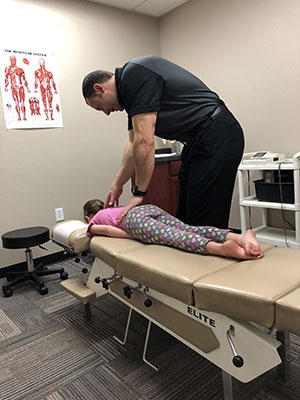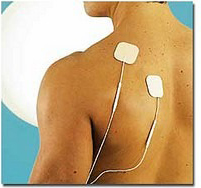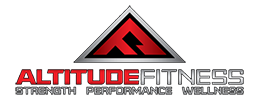Chiropractic
The chiropractic adjustment is also referred to as a spinal “manipulation”. During this procedure, the doctor applies his / her hands to the area of the spine to be treated in such a way as to mobilize the joints. Most commonly, the doctor will administer a quick, short hands-on movement to the joint. The joint usually elicits a “pop” or “crack,” similar to when “cracking” one’s knuckles. Patients usually sense movement of the joint.
The goal of the chiropractic spinal manipulation is to:
Increase the joint mobility / range of motion
Relieve pain
Reduce muscle spasm
Restore optimal joint function
Joint mobilization
Mobilization is a form of stretching that is applied to stiff joints in order to optimize and restore range of motion, relieve pain and reduce muscle tension. These procedures consist of small passive movements, usually applied as a series of gentle stretches in a smooth, rhythmic fashion to the individual’s joints. Mobilizations may be administered in various gradations or degrees of pressure, depending upon the sensitivity and stiffness of an individual’s joints.
Types of Chiropractic Care
The number of treatments required to effectively help a patient is very individual. There are many factors that may influence a person’s recovery. For example, the individual’s healthcare goals, overall health status, severity of the injury, how long the problem has been present, fulfillment of home/office therapies, and how many prior injuries have occurred.
Some patients simply seek relief from their immediate pain and may require only a few treatments, whereas others prefer to experience optimum health and require more intensive and comprehensive care. The decision is always up to the patient.
Some people make chiropractic adjustments part of their routine health maintenance, although the value of this type of care has not been scientifically investigated.


Active Care
There are four major types of chiropractic care – Acute Care, Remobilization, Reactivation and Rehabilitation
Acute care is provided during the first few days following an injury. It is intended to relieve pain, inflammation and muscle spasm. Therapeutic modalities such as ice, electrical muscle stimulation and ultrasound may be used to help achieve these results.
Remobilization is that stage of treatment directed at restoring optimal mobility and flexibility to a patient’s joints and muscles. Spinal manipulation (adjustments) and muscle release techniques are often used to accomplish these goals.
Reactivation care is when exercises and flexibility training are introduced into the treatment program. Scientific studies have shown that early introduction of exercise in the treatment process facilitates more rapid recovery from an injury and helps to prevent reocurrences.
Rehabilitation is the stage of care when more intensive training is necessary. This is the time when coordination, strength and endurance are emphasized. The goal of rehabilitation is to prevent recurrence of symptoms and re-injury. The ultimate objective of this treatment is to teach patients how to control their own symptoms and condition through exercise and correct posture. Depending on the patient’s needs, one area may be emphasized.
Supportive Care
After a patient has completed active care and has been discharged, supportive care may be indicated.
Soft Tissue Therapies
Trigger Point Therapy
During this procedure, deep manual pressure is applied to and held on sensitive pressure points within muscles. This procedure usually reproduces discomfort in the area of a patient’s complaint, as well as under the point or pressure. Trigger point therapy is used to relieve painful trigger points and their characteristic referred symptoms.
Active Release Techniques®
ART is a patented, state of the art soft tissue system/movement based massage technique that treats problems with muscles, tendons, ligaments, fascia and nerves. Headaches, back pain, carpal tunnel syndrome, shin splints, shoulder pain, sciatica, plantar fasciitis, knee problems, and tennis elbow are just a few of the many conditions that can be resolved quickly and permanently with ART. These conditions all have one important thing in common: they are often a result of overused muscles.
What is an ART treatment like? Every ART session is actually a combination of examination and treatment. The ART provider uses his or her hands to evaluate the texture, tightness and movement of muscles, fascia, tendons, ligaments and nerves. Abnormal tissues are treated by combining precisely directed tension with very specific patient movements. These treatment protocols – over 500 specific moves – are unique to ART. They allow providers to identify and correct the specific problems that are affecting each individual patient. ART is not a cookie-cutter approach.
Please visit the following link for more ART info: http://www.activerelease.com
Myofacial Release
Soft tissue is defined as muscles, ligaments, fascia, tendons and nerves. These tissues are the structures that hold your skeletal system intact and allow it to move and function. When these structures become injured or inflamed due to direct trauma, repetitive stress, overuse, and nutritional deficiencies, they become scarred and sticky. These structures stick to surrounding structures which prevents full movement, causes pain, weakens the muscles and leads to chronic problems. The analogy is muscle should be like a rubber band and soft tissue injury causes them to become a rope. We feel that that these structures MUST be evaluated and treated.
Transverse Friction Massage (TFM)
Scar tissue forms when inflammation is present after an injury. The presence of scar tissue often leads to a significant loss of function. Transverse friction massage (TFM) involves deep pressure with specifically directed movement in order to remodel scar tissue allowing the soft tissue to become more flexible, pliable, and more functional.

Kinesio Taping® and Kinesio® Tex Tape
The Kinesio Taping® Method is applied over muscles to reduce pain and inflammation, relax overused or tired muscles, and support muscles in movement on a 24-hour-a-day basis. The taping is non-restrictive and allows for full range of motion. In contrast, more traditional sports tape is wrapped around a joint strictly for stabilization and support during an athletic event. Kinesio® Tex Tape is used to treat anything from headaches to foot problems and everything in between. Just a few examples include rehabilitation from sports injuries, carpal tunnel syndrome, lower back strain/pain (subluxation, herniated disc), knee and shoulder conditions. There are many more.
The Kinesio Taping® Method is a definitive rehabilitative taping technique that is designed to facilitate the body’s natural healing process while providing support and stability to muscles and joints without restricting the body’s range of motion as well as providing extended soft tissue manipulation to prolong the benefits of manual therapy administered within the clinical setting. Latex-free and wearable for days at a time, Kinesio® Tex Tape is safe for populations ranging from pediatric to geriatric, and successfully treats a variety of orthopedic, neuromuscular, neurological and other medical conditions. The Kinesio® Taping Method is a therapeutic taping technique not only offering your patient the support they are looking for, but also rehabilitating the affected condition as well. By targeting different receptors within the somatosensory system, Kinesio® Tex Tape alleviates pain and facilitates lymphatic drainage by microscopically lifting the skin. This lifting affect forms convolutions in the skin thus increasing interstitial space and allowing for a decrease in inflammation of the affected areas.


McKenzie Technique©
The McKenzie© Method was developed in the 1960’s by Robin McKenzie, a New Zealand physical therapist. During the course of his practice, he discovered that extending the spine (backward bending) could provide significant relief from low back and lower extremity pain for certain patients. This represented a significant shift in thinking for spine care practitioners, as much of the focus of spine care previously was on flexing (forward bending) the spine.
With the McKenzie approach, a step-by-step examination identifies the movements and postures that best relieve a spine pain sufferer’s complaints. The focus of the examination is on identifying which movements and postures “centralize” the patient’s pain. That is, which positions and activities reduce any extremity (or “perhiperal”) symptoms. The theory of the approach is that centralizing the pain allows the source of the pain to be treated rather than the symptoms.
A central tenent and goal of the McKenzie Method is to teach neck pain and/or back pain sufferers how to treat themselves and manage their own pain for life using exercise and other strategies..
Flexion-Distraction
Flexion/distraction manipulation is used to decompress the spinal joints by applying a gentle stretch, or traction, to the lower spine. It is usually applied in a series of repetitive slow movements without dynamic thrusts. The procedure is often used for people with disc problems, lumbar stenosis and facet syndrome, and may also be used in other ways, such as to gently mobilize joints.

Stretches and Exercises
Our patients learn to perform home stretches and exercises to improve their overall fitness and health. Condition specific exercises and stretches are customized to each patient’s physical needs. Descriptive handouts are provided to facilitate ease of implementation.
Proprioceptive Neuromuscular Facilitation (PNF)
PNF stretching is an advanced form of flexibility training and is considered to be the fastest and most effective way to increase static flexibility. Overall, PNF flexibility training reduces post workout soreness, decreases musculoskeletal injury, increases range of motion, and improves muscular strength and coordination.
Therapeutic Modalities
Short courses of some therapy modalities may facilitate pain relief and muscle relaxation. We provide the following therapy modalities very conservatively, in order to facilitate exercise-based treatments.
Electrical Muscle Stimulation
Often referred to as “muscle stim,” the therapy involves low levels of electrical impulses delivered to the injured, painful tissues to reduce pain and speed healing. Often described by patients as a pleasant, “tingling” sensation, or “electrical massage,” these impulses stimulate the body to release natural pain relievers, called endorphins. These endorphins reduce pain and inflammation, thereby promoting faster healing of the injured tissues. This therapy is often used to treat acute or chronic pain, as well as strains or sprains of the muscles, joints, and soft tissues of the spine and extremities.
Theraputic Ultrasound
Therapeutic Ultrasound is a deep heating modality that emits high-frequency acoustic vibration that is above the human audible spectrum. Therapeutic ultrasound reaches underlying tissues as deep as 1 to 5 centimeters.
When electrical energy is applied to a crystal, it causes it to vibrate at a high frequency and to produce ultrasound. Ultrasound is delivered by continuous or pulsed wave and provides a high heating intensity. Therapeutic ultrasound stimulates the repair of damaged tissues, relieves pain, increases blood flow, relaxes muscle spasms, and may speed the healing process.
Interferential Therapy
Interferential current therapy involves administering alternating electrical currents through electrodes placed on the skin at a painful area, or the spinal nerve root associated with a painful region. It is theorized that the low frequency of the interferential current affects the nervous system in such a way as to result in muscle relaxation, suppression of pain and acceleration of healing.
Moist Heat
Moist heat is used to heat the muscles and increase blood flow and cellular activity. It is often used prior to treatment to help relax the large muscle groups in the back. Often times it is used in simotanously with muscle stimulation.


Sign up for our Newsletter
Get the latest news and information from us when you sign up for our newsletter.







